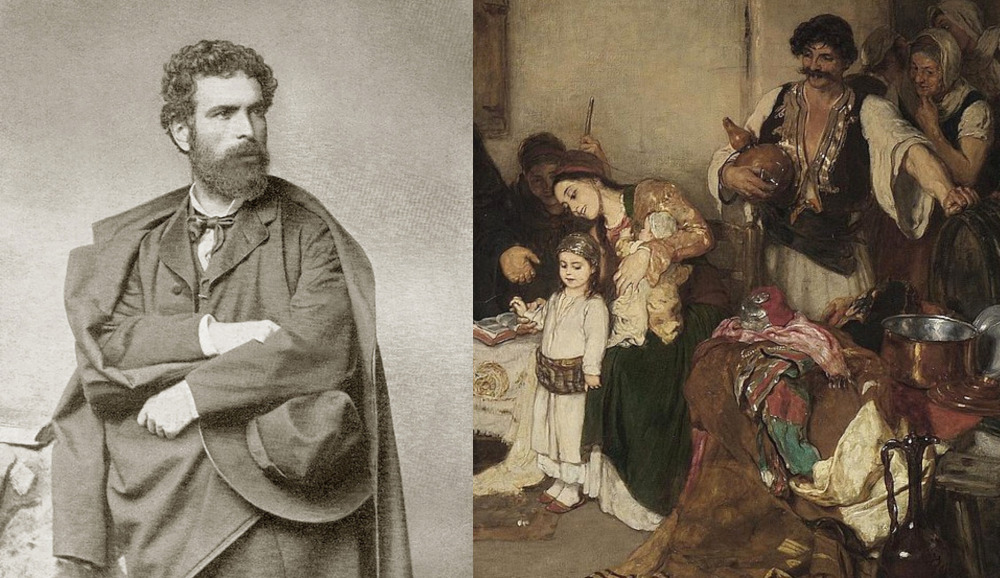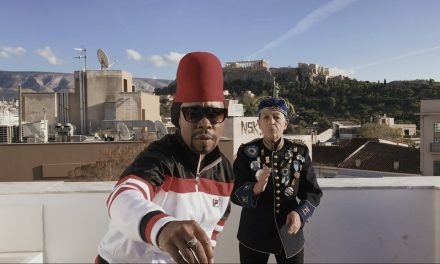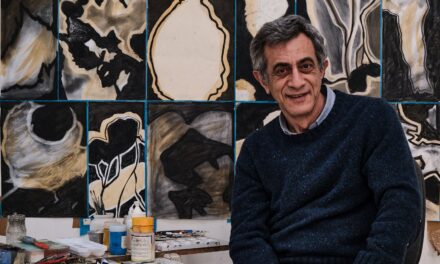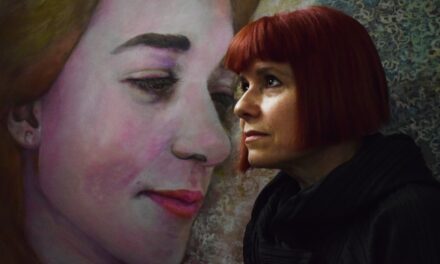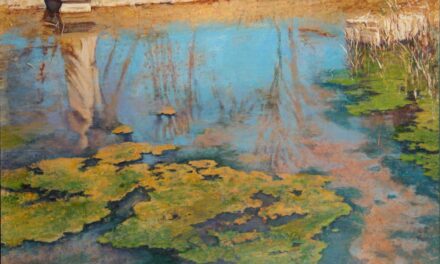Nikolaos Gyzis (1842-1901) was one of the most prominent Greek artists of the 19th century and an iconic representative of the so-called Munich School, which defined the artistic scene of the nascent Greek state. Famous for his genre paintings but also his allegories, he is mostly remembered for his portrayals of everyday life, often depicting rural scenes inspired from the historical period before the Greek Revolution.
The “Munich School” in Greece
In the 19th century, the prevalent style in Greek art was academic realism. Because studies in the fine arts had not yet reached a high level in the newly founded Greek state, artist aspiring to a prominent career chose to continue their studies abroad. Due to Greece’s close ties with Bavaria, following the appointment of Bavarian prince Otto as the first King of Greece, artists were encouraged to study at the Royal Academy of Fine Arts of Munich, which was considered one of the most important institutions of its kind in Europe. The Munich school is characterized by a naturalistic style, moving away from the Romanticism of early 19th century; typical subjects include landscape, portraits, genre, still-life, and history painting.
Genre painting is particularly associated with the Munich School, especially in Greece, where it is known as ropographia (“depiction of trivial things”), but predominantly referred to as ethographia (literally “study of mores”), a term borrowed from Greek literary criticism. Subjects are drawn from everyday life, especially in a rural context. Seventeenth-century Dutch art and German Biedermeier painting have been suggested as important influences on Greek genre painting of the time, especially due to their similarities in themes and iconography.
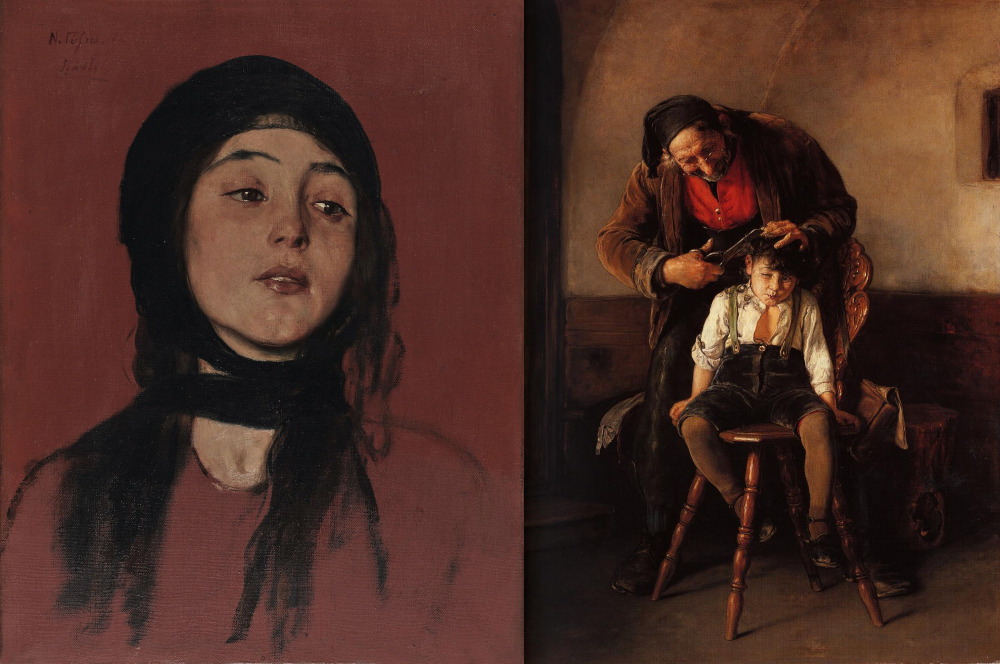 Left: Wishbone, 1878 (National Gallery of Athens); Right: The barber, 1880 (Private collection)
Left: Wishbone, 1878 (National Gallery of Athens); Right: The barber, 1880 (Private collection)
Life and career of Gyzis
Gyizis was born in the village of Sklavochori, on the island of Tinos, on 1 March 1842. His father was a carpenter with five more children. In 1850, his family moved to Athens. There he started attending classes at the School of Arts (the predecessor of the Athens School of Fine Arts) initially as an auditor; he later officially enrolled and completed his studies in 1864.
In July 1865, he went to continue his studies at the Munich Academy of Fine Arts on a scholarship. There, he would shortly reunite with fellow Greek artist Nikephoros Lytras –arguably the only representative of the Greek Munich School whose reputation rivals that of Gyzis himself– who had been studying at the Academy since 1860. The two men were close friends, and would later go together on trips to Asia Minor and Paris.
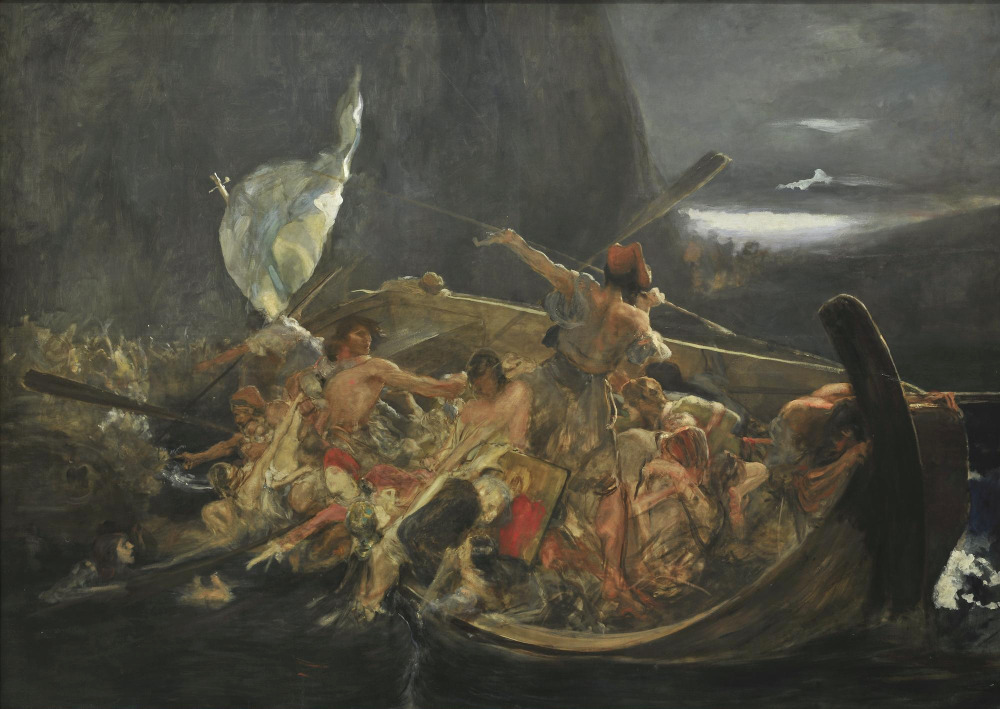 After the Destruction of Psara, ca. 1896-1898 (National Gallery of Athens)
After the Destruction of Psara, ca. 1896-1898 (National Gallery of Athens)
In 1868, Gyzis was accepted at the workshop of renowned painter Karl von Piloty, one of The Academy’s most important professors. In 1869, he was he discovered the work of French realist painter Gustave Courbet, thanks to an international exhibition in Munich. Courbet’s style had a great impact on Gyzis. He also established close ties with the circle of the German realist painter Wilhelm Leibl (the so-called Leibl-Kreis), a group of artists also deeply inspired by Courbet, as well as 17th century Dutch painting. Gyzis formed friendly relations with the painters Franz von Defregger, Eduard Kurzbauer and later Franz von Lenbach.
In 1872, Gyzis returned to Greece to work there as a painter, but two years later he decided to move back to Munich, were he would reside for the rest of his life. He married a Greek woman in 1977, with whom he had five children.
He gained increasing recognition in Germany, participating in world fairs and winning critical acclaim. Between 1878 and 1880 he was commissioned the decoration of the ceiling in the Museum of Decorative Arts in Kaiserslautern. In 1880 he became an honorary member of the Academy of Fine Arts; he was made an assistant professor in 188 and a professor in 1888. He would teach at the Academy until his death from leukemia in 1901.
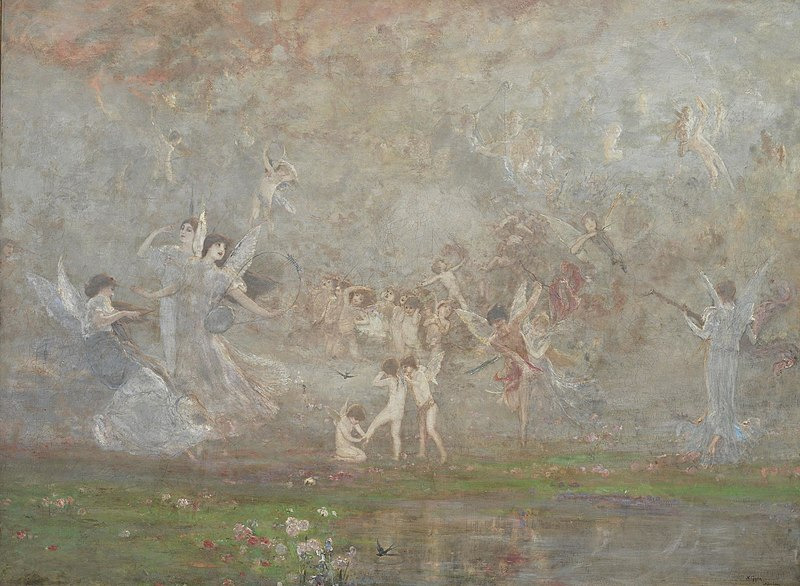 Spring Symphony, 1886 (National Gallery of Athens)
Spring Symphony, 1886 (National Gallery of Athens)
Artistic style
Nikolaos Gyzis is predominantly known for his genre paintings, with themes inspired from Greek rural life, often depicting scenes alluding to life under the Ottoman rule, evidently influenced by the current of Orientalism. His naturalistic depictions demonstrate a strong emphasis on detail, along with the use of vivid colours and carefully conceived compositions.
The painter’s later works, especial after the mid-1880s, his work moved increasingly toward more progressive areas—specifically, Symbolism and Jugendstil (the German counterpart of Art Nouveau). As a deeply devout person, he would also increasingly incorporate religious themes into his works, and create deeply allegorical paintings, which marked his move further away from academic art and towards a more expressionist style.
Famous works
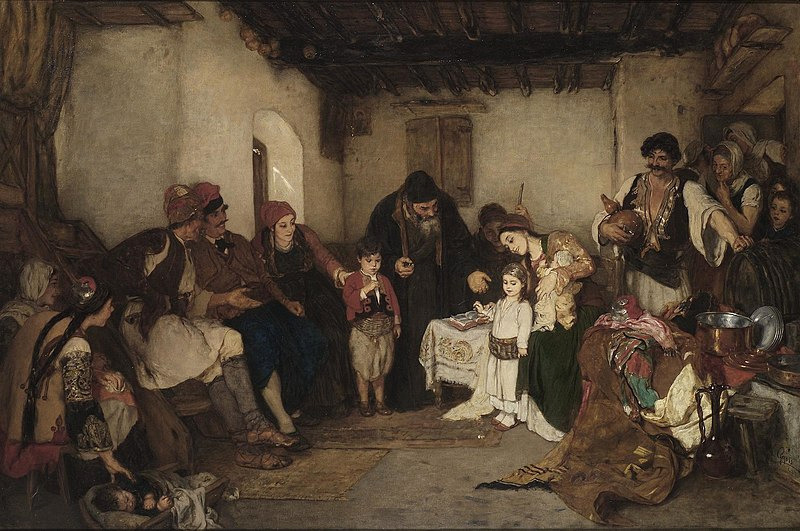
The Betrothal of the Children, 1877 (National Gallery of Athens)
The work portrays a ceremony for the engagement of two children by their families. This practice is believed to have served in the past for the protection of young boys from devşirme (“blood tax”), known in Greek as Paidomazoma (“the taking of children”), i.e. an Ottoman child-tribute levied in the Balkans. Although the forcible recruitment of soldiers from among the children of their Balkan Christian subjects is a well-documented Ottoman institution in the 15th and 16th centuries, the practice had effectively stopped by 1648 and thus would not exist in the era depicted in the painting. This is the second version of a work created by Gyzis in 1875, which belongs to a private collection.
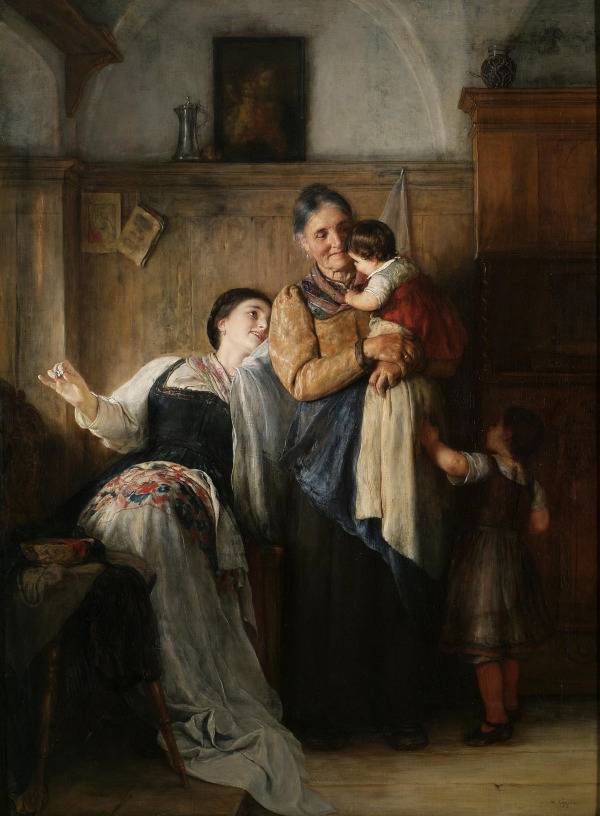
Peak-a-Boo, 1882 (National Gallery of Athens)
This work is representative of genre painting, portraying a moment of everyday life, in a naturalistic style. The subject and style are believed to show a direct influence from Austrian artist Franz Defregger (1832-1921), professor of history painting from 1878 to 1910 at the Munich Academy, with whom the artist had friendly relations. It is suggested that Gyzis’s own family served as models for the painting.
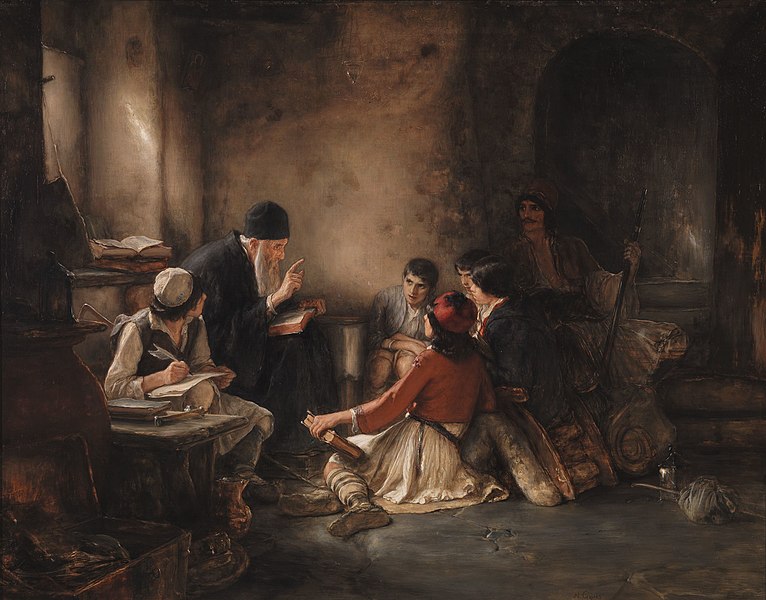
The secret school, 1886 (Emfietzoglou Gallery)
The painting is inspired by a widespread, mostly oral, tradition regarding the period of Ottoman rule, according to which young Greeks had to resort to clandestine education, the so-called Krifó scholió (“secret/underground school”), usually hidden in monasteries. There is little evidence to support that the use or teaching of the Greek language was persecuted at any point during this period; the Ottomans are believed to have been for the most part indifferent towards it. This however also meant the lack of an official public education system. The Ecumenical Patriarchate of Constantinople, responsible for most aspects of civil administration for the Christian population, did support the operation of public Greek schools, especially in large towns. Local elementary schools were also closely linked with the Orthodox church; they were often run and/or subsidised by monasteries, while teachers were in fact usually priests or monks.
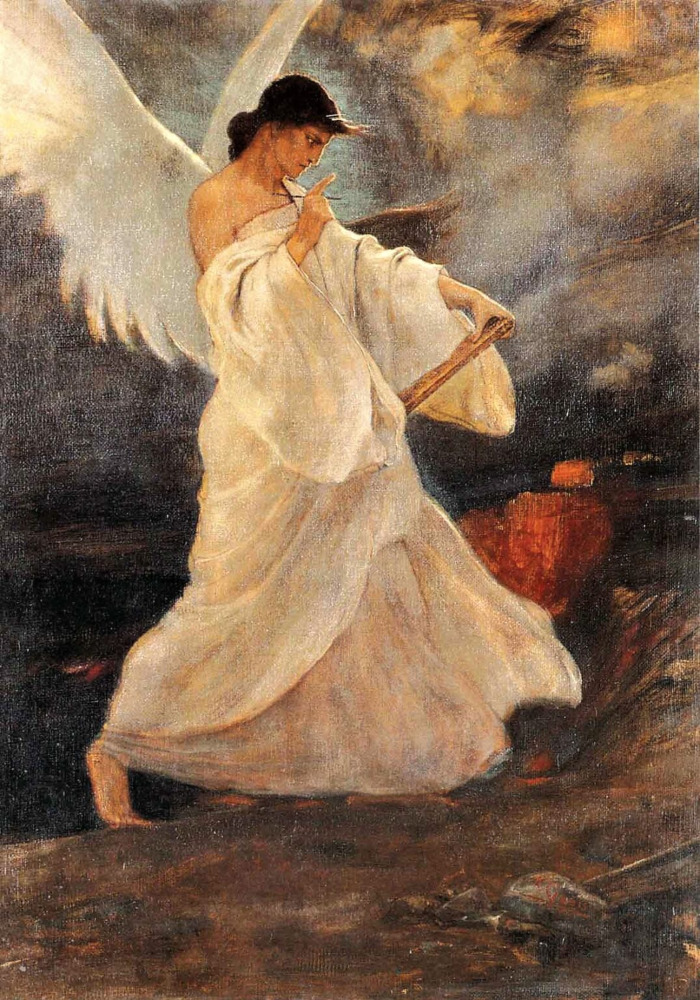
Glory, ca. 1898 (Presidency of the Hellenic Republic)
The painting was until recently in the possession of a private collector, who donated it to the Presidency of the Hellenic Republic, on the occasion of the bicentenary of the Greek War of Independence of 1821, due to its status as an important example of iconography linked with the Greek Revolution. As in his previous work, After the Destruction of Psara (ca. 1896-1898), Gyzis draws his subject from the tragedy of the Greek island of Psara, where the Ottomans slaughtered a large part of the civilian population on July 5, 1824. As in the Chios massacre of 1822, the mass killings caused international outrage.
More specifically, the painter is inspired by Dionysios Solomos’s famous epigram on the destruction of Psara in 1824, where he imagines the personification of Glory “walking alone” on the island’s “blackened ridge”, crowned with a few leaves of grass from the deserted earth. The theme is reprised in the famous sketch Glory of that same year (on view at the Nafplion Annex of the National Gallery). The painting is representative of the style which characterises his latest works, influenced by Symbolism and moving from genre painting towards allegories.
Read also via Arts in Greece: Nikephoros Lytras, the Artist behind Greek Christmas’ Most Celebrated Painting; Sophia Laskaridou, the first woman at the Athens School of Fine Arts; Konstantinos Volanakis: the Father of Greek Seascapes; The visual representation of the 1821 Greek War of Independence through the eyes of Greek and foreign artists; The portrayal of women in Modern Greek painting
N.M. (Left: Photographic portrait of Gyzis; Right: The Betrothal of the Children [detail], 1877)

